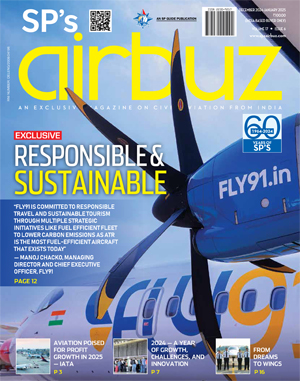Budget 2014: Impact on Indian Aviation
Considering that this newly elected government has shown pro-reform intentions right from day one and also the fact that the governance is an ongoing process and not restricted to an event such as a budget, there is a high probability of the issues concerning such a vital industry as aviation being addressed sooner than later

The aviation industry has a multiplier effect on the economic development of a region. When an airport is developed in an area, the effect is felt across the directly and indirectly related industries by way of speedy movement of goods and passengers. The population, industry and infrastructure invariably converge on the airport thereby resulting in increased business and tourism activities. This, along with the creation of employment opportunities, results in increased consumer spending thereby positively impacting profits of the companies producing goods and providing services.
The strategic airport infrastructure development and globally competitive tariff regime combined with incentives to Airlines and maintenance, repair and overhaul (MRO) companies can result in the development of aviation hubs similar to Dubai and Singapore. And when that happens, the enormous domestic and international traffic flying through the hub creates a massive positive ripple effect on the economy of the entire region/country. India is the second most populated country and the third largest economy and strategically located as well. However, the fact that our air traffic as percentage of population is only six per cent as against Malaysia’s 150 per cent, Singapore’s 567 per cent and Philippines’ 29 per cent, provides an indicator to India’s tremendous untapped potential.
Industry Scenario
Being among the top ten aviation markets in the world, India has the vision to be the third largest by 2020. Domestic passenger traffic handled at airports in India rose marginally to 122.43 million in 2013-14 as against 116.37 million the previous year. With 46.62 million passengers in 2013-14 in comparison to 43 million in 2012-13, a similar trend is visible in international passenger traffic as well. Airport infrastructure has improved a great deal with the construction of greenfield and brownfield airports through the public-private partnership (PPP) model. Out of five major airlines in India, four are operating on both domestic and international routes. However, due to the high operating costs and inefficiencies, most of them are in the red.
Following are some of the vital indicators of the relevance and regulatory health of the industry:
- Contribution to GDP: As per the study conducted by Oxford Economics for International Air Transport Association (IATA) in 2011, based on data of 2009, the total contribution of the aviation industry to the Indian economy is Rs. 1.24 trillion or 1.5 per cent of its GDP. Whereas direct Contribution is Rs. 330 billion or 0.5 per cent of GDP, the indirect (through catalytic effect on related sectors/services) contribution is Rs. 912 billion or one per cent of its GDP.
- Creation of Employment Opportunities: As per the study mentioned in the para above, whereas 1.7 million people are directly employed by the aviation industry, indirect employment is to around 7.1 million.
- Foreign Direct Investment:
- Greenfield Projects- Foreign direct investment (FDI) up to 100 per cent is permitted under the automatic route subject to sectoral regulations notified by the Ministry of Civil Aviation.
- Existing Projects- FDI up to 100 per cent is allowed, however beyond 74 per cent FDI, the approval of FIPB is required and also, it is subject to sectoral regulations notified by the Ministry of Civil Aviation.
- Air Transport Services
Scheduled Air Transport Service/Domestic Scheduled Passenger Airlines: FDI up to 49 per cent and investment by non-resident Indians (NRIs) up to 100 per cent is allowed on the automatic route subject to sectoral regulations notified by the Ministry of Civil Aviation and no direct or indirect participation by any foreign airlines is permitted.
Non-Scheduled Air Transport Service/Non-Scheduled, Chartered and Cargo Airlines: FDI up to 74 per cent and investment by NRIs up to 100 per cent allowed on the automatic route subject to sectoral regulations notified by Ministry of Civil Aviation and no direct or indirect participation by any foreign airlines in Non-Scheduled and Chartered Airlines. Foreign airlines are allowed to participate in the equity of companies operating cargo airlines.
Helicopter Services/Seaplane Services: FDI up to 100 per cent allowed on the automatic route subject to sectoral regulations notified by Ministry of Civil Aviation with the approval of Directorate General of Civil Aviation (DGCA). Foreign airlines are allowed to participate in the equity of companies operating Helicopter and Seaplane Services.
Foreign airlines are allowed to invest up to 49 per cent in domestic carriers.
- Key Concerns
- Taxation
There is high and non-uniform taxation regime due to state sales tax on Aviation Turbine Fuel (ATF). ATF in India is 65 per cent costlier than the Gulf and ASEAN countries accounting for nearly half the operating costs. - Airport charges are one of the highest in the region. As per the IATA Annual Report 2013, there is an increase of 346 per cent in charges at the Delhi International Airport Ltd (DIAL) in 2012 which was contributed by the decision of the Airport Economic Regulatory Authority (AERA) to allow the returns over five years at DIAL to be recovered in less than two years. This had its ripple effect wherein other airports too raised the charges increasing overall operating cost.
- High taxation on MRO in India has led to around 85 per cent of the MRO services availed of outside India resulting in the drain of foreign exchange loss of jobs besides increasing operating costs.
- Infrastructure
There is lack of incentive/policy push to develop low-cost airports and terminals. - Policies
The regulatory structure not being in conformity with international expectation/practices has resulted in downgrade by the US Federal Aviation Administration (FAA) of the safety rating of Indian civil aviation. This not only affects the existing airlines like Jet Airways and Air India but also others as they would not be permitted to operate additional flights to the United States unless the FAA upgrades Indian aviation to Category 1. The fact that the Indian airlines can be subjected to additional checks at the airports in the United States passenger comfort/service is likely to be adversely affected which may result in loss of business.
- Key Expectations
- Rationalisation of Central/state taxes on ATF and MRO would bring down the aircraft operating cost. ATF could be brought under “declared goods category” for uniform taxation across the country.
- A hassle-free customs procedure for import of aircraft parts and consumables, rationalisation of indirect taxation (service tax and VAT) and minimum 10-year tax holiday in line with SEZ incentives, can provide the much desired impetus to MRO activity in India.
- Financial/tax incentives may be provided for speedy modernisation of existing airports. Sec 80IA benefit (10-year tax holiday) which is available for new airport projects, can also be provided for capital intensive activities like airport upgradation and fuel farms.
- Abolition of minimum eligibility criteria for Indian carriers to fly international (5/20 rule). As per this rule, an Indian carrier must have operated for five years and have a fleet of at least 20 aircraft to fly abroad. The abolition of this rule is likely to benefit the new entrants AirAsia India and Tata-SIA who will then be able to operate international flights without any restrictive condition on experience and fleet size.
Budget 2014-15
Outlay: As against the 2013-14 Budget outlay of Rs. 8,865.40 crore, outlay for 2014-15 is Rs. 9,474 crore (plan— Rs. 6,720 crore and non-plan— Rs. 2,754 crore). This outlay being almost 11 per cent higher, predominantly caters to Air India ( Rs. 7,069 crore) and Airports Authority of India ( Rs. 2,134 crore).
Key Initiatives: The Finance Minister gave voice to the aspirations of the Indian public and said, “Despite increase in air connectivity, air travel is still out of reach for a large number of Indians. The scheme for the development of new airports in Tier-I and Tier-II cities will be launched for implementation through the Airports Authority of India or PPPs.” If implemented in right earnest on a warfooting, the modern low-cost airport network across the nation will not only be a booster dose to the aviation industry but will also augment the socio-economic growth of the nation.
In his budget speech, although the Finance Minister acknowledged that air travel is out of reach of most, expected decisions/policy measures, capable of accelerating the growth of the aviation sector in the short to medium term, were not announced in this budget. The Government’s ambitious plan, to build 200 low-cost airports in the next 20 years to connect Tier-II and Tier-III cities and fulfill its vision of brining air connectivity within the reach of the aspiring Indians, will achieve desired results only if augmented by policy incentives to bring down airline operating costs. Therefore, the government will most likely re-visit the sales tax issue on ATF and also incentivise MRO activity sooner.
Considering that this newly elected government has shown pro-reform intentions right from day one and also the fact that the governance is an ongoing process and not restricted to an event such as a budget, there is a high probability of the issues concerning such a vital industry as aviation being addressed sooner than later.
The writer is an ex-IAF Pilot and IIM Ahmedabad alumnus specialising in Aviation Law & Business Strategy. Currently, he is working as Principal Associate - Aviation & Aerospace at MV Kini Law Firm.





